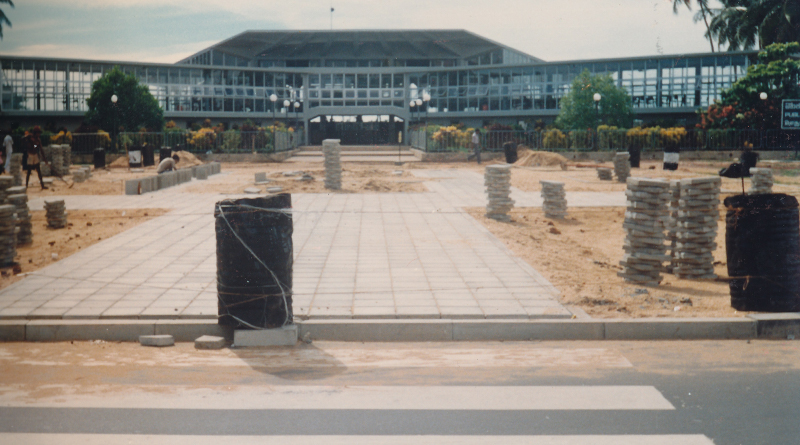The road to a Canadian friendship.
By Senaka Samarasinghe
Aviation History in Sri Lanka
1934 was a remarkable year in aviation history for Ceylon (now Sri Lanka). The state council made a decision to construct an aerodrome to accommodate lightweight aircraft 15 km south of the capital city of Colombo, near a town named as Ratmalana. On November 27, 1935, the first aircraft was landed on the new Ratmalana tarmac. The pilot was chief flying instructor of the Madras Flying Club, Mr. Tyndalle Bisco. The aircraft was a De Havilland Puss Moth.
In 1944, during the Second World War, the Royal Air Force (RAF) established a military airfield in Katunayake, 32.5 km north from the capital city of Colombo. In 1957, the RAF removed all British military personnel and aircraft from Sri Lanka and handed the airfield over to the Royal Ceylon Air Force.
Construction of two airports: Winnipeg and Colombo (Katunayaka)


Tallman Construction Company, based in Winnipeg, specialized in runways and airport construction. It all started when they built the first drive-in theatre on Pembina Highway. This project had given them a good reputation. Subsequently they began to specialize in building airports. Their first bid was on the Portage la Prairie airport for the Canadian Forces base to train Royal Canadian Air Force and NATO pilots. This was followed by construction of airports across western and northern Canada with two runways (11,000 feet) at the Edmonton airport. During the same period, they diversified activities and started joint venture projects with Henry J. Kaiser for dam building. Their first such dam was across North Saskatchewan River.
On January 7, 1964, the new Winnipeg terminal was opened on the east side of the Winnipeg International Airport beside the runways constructed by Tallman. The architects were Green, Blankstein, Russell and Associates and principal design done by Bernard Brown and David Thordarson.
At the same time, in 1963, Canada was working with Sri Lanka on construction of the runway and terminal building for an airport in Colombo. The government of Sri Lanka decided to construct the new airport in RCAF airfield.
In 1967, with Canadian aid, they started building a new international airport at Katunayake to replace Ratmalana. This was a revolutionary year in air, sea, rail and road in Sri Lankan transport history. Port Tally and Protective Services Corporation was formed in Colombo Port on the same year. During this year, employees’ councils were established to help run the Ceylon Government Railway. The Ceylon transport board constructed Central Bus Stand close to the railway station of Colombo.
While Canada was trying to help the KAP project, Tallman Construction Company was establishing its name in airport construction in western Canada. As a result, the same company obtained the contract for KAP project. They made few changes to the terminal building plan and completed Katunayaka terminal building. The runway KAP was also the same length as the Edmonton runway.
Katunayaka Airport Project (KAP) was Canada’s largest single aid program to Sri Lanka. Media named it “the showpiece of the East” due to the 80 percent grant and a loan of 20 per cent. The project was completed three months ahead of schedule and TWA, Aeroflot, UTA, Quantas and British Eagle Airways started operating their scheduled flights.
August 5, 1968, Katunayaka was opened along with its peripherals including the runway, terminal building, apron and taxiway. In 1968, airport regulations were gazetted by the government of Sri Lanka.
Migration: Between Winnipeg and Colombo
Among the Sri Lankan workforce of Tallman Construction Company three bachelors expressed their willingness to migrate to Winnipeg. During the initial stage of soil testing a Sri Lankan was attached to this company. Subsequently this young man was identified by the company to serve as the maintenance supervisor (on behalf of the company) of the terminal building of the KAP. Cyril Perera settled down in Winnipeg in 1968. Before joining this firm Mr. Perera served in the Ceylon defence force for five years.
That was the period the city of Winnipeg concentrated on its second longest road Pembina Highway (15 km). With his construction experiences, Mr. Perara was offered a job in the Pembina road project. This was his first appointment in Canada, giving him the opportunuity to work on one of the city’s oldest and most historic roadways. Previously known as Highway No. 75, it started operations in the 1850s.
Later Mr. Perera was engaged in numerous projects and retired in 1994. He served as a power engineer in Manitoba Telephone System. Mr. Perera was a dedicated volunteer at the Western Canada Aviation Museum, founder of the Friends of the Assiniboine Conservatory and busy with other church and community groups as well. He passed away August 13, 2013.
